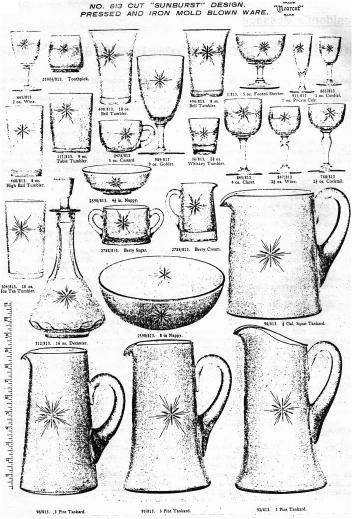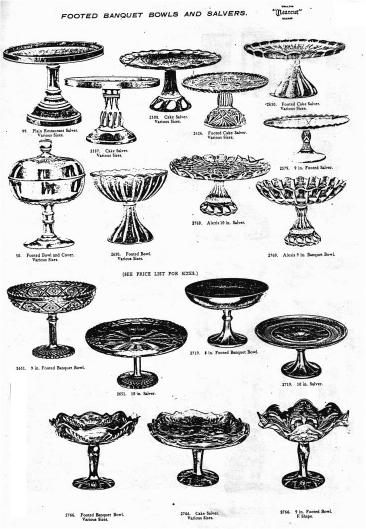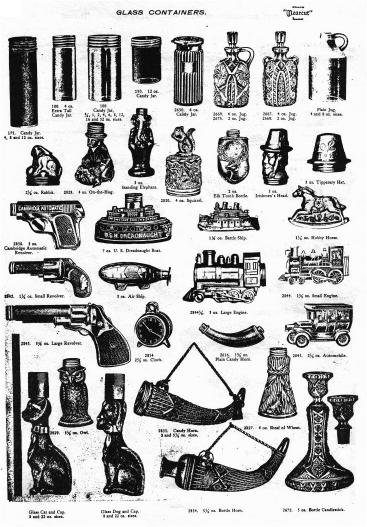How It All Began - Part V
by Mark Nye
Issue No. 284 - December 1996
This month's article, for the most part, lets the "pictures do the talking," to paraphrase a familiar commercial. Most of the catalog pages shown this month were originally part of a Cambridge catalog issued about 1916. Those pages showing the No. 2699 line fancy novelties are from the Cambridge Catalog #10 issued about 1920.
While called No. 813 Cut "Sunburst" Design, the pattern also resembles a star and thus most appropriate for use at Christmas. Unfortunately few, if any, collectors will be able to set a table with this pattern since it is seldom seen today. Toothpick holder collectors take note of the piece in the upper left corner of the page. (Note: this page entitled "No. 813 Cut 'Sunburst' Design" is reproduced at the end of the article.)
No. 2729 design (at right) is known to Pattern Glass collectors as "Star with
Handle" and was introduced during the years 1910-1915. Made until
 sometime in the early 1920s, it was designated a "Medium Pressed" line.
Never named by Cambridge, "Star with Handle" is quite descriptive. The
"handle" is readily seen on most pieces and is very prominent on tall
items. The star in #2729 has twelve points, including the point that
serves as the handle. No. 2656, or Star of Bethlehem, seen in a
previous article, has either a six or eight point star.
sometime in the early 1920s, it was designated a "Medium Pressed" line.
Never named by Cambridge, "Star with Handle" is quite descriptive. The
"handle" is readily seen on most pieces and is very prominent on tall
items. The star in #2729 has twelve points, including the point that
serves as the handle. No. 2656, or Star of Bethlehem, seen in a
previous article, has either a six or eight point star.
The page captioned "FOOTED BANQUET BOWLS AND SALVERS" features pieces from a number of lines, a few of which were originally made by another company. The line Cambridge called No. 2769 was made by Dazell, Gilmore & Leyton as the Alexis pattern prior to the molds coming to Cambridge.
Most of the novelty containers shown on the page captioned "GLASS CONTAINERS" were designed to be filled with candy. However, several were intended for liquids, perhaps "adult type beverages." These are the cat and dog, the bottle horn and bottle candlestick. Today, adult Cambridge collectors would be most appreciative if one or more of these candy containers appeared under their Christmas tree full or empty.
Buzzsaw or No. 2699 line entered the Cambridge catalog between 1910 and 1915 and continued to be offered until the early 1920s. As with most Cambridge lines, this should not be taken to mean all pieces in the line were in production for the entire time period. Oftentimes the number of items available tended to decrease as the line aged. The orange bowl and foot and the three-piece epergne as they appear on the different catalog pages is shown with two styles of "foot." The foot used on the catalog page has rings near its "top" while the nine-inch sweet pea vase used as the alternate foot does not. Filled with flowers, fruits and nuts, these pieces enhanced yesterday's holiday tables and would certainly do the same today. Lucky is the collector who could decorate a holiday table with one of these pieces.




